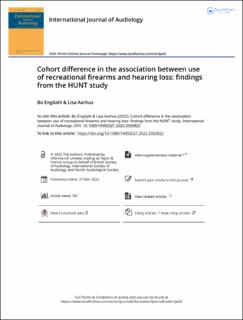Cohort difference in the association between use of recreational firearms and hearing loss: findings from the HUNT study
Peer reviewed, Journal article
Published version
Permanent lenke
https://hdl.handle.net/11250/3046327Utgivelsesdato
2022Metadata
Vis full innførselSamlinger
- Artikler [5068]
- Publikasjoner fra CRIStin FHI [7544]
Sammendrag
Objectives:The risk of noise injury from recreational firearm use is well known. Despite preventive meas-ures it is uncertain whether it has become less harmful. We assessed whether the association betweenrecreational firearm use and hearing has changed during the last two decades.Design:We used a repeated cross-sectional design and determined hearing thresholds by pure-tone audi-ometry. Frequency-specific associations between recreational firearm use and hearing thresholds wereassessed by multivariate linear regression stratified by sex and adjusted for age and other covariates.Study sample:Two cross-sectional population-based cohorts 20 years apart (1998 and 2018) comprised 27,580(53% women, mean age 53 years) and 26,606 individuals (56% women, mean age 54 years), respectively.Results:Recreational firearm use was reported by 28% in 1998 and 30% in 2018. The proportion thatreported wearing hearing protection increased. Exposure to recreational firearms was associated with ele-vated thresholds at 3-6 kHz in both cohorts. The association increased with the number of lifetime shots.The associations increased by age and were substantially smaller in the most recent cohort.Conclusions:Analyses of two cohorts revealed a reduction in the association between recreational fire-arm use and hearing over 20years, coinciding with the introduction of hearing preservation measures
